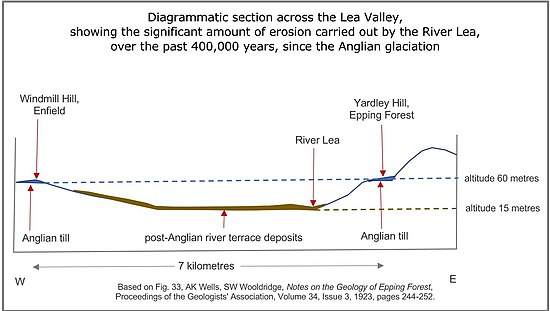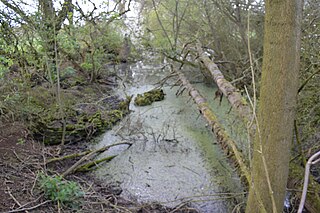Geography
Physical geography
The catchment area of the River Lea is located in the central part of the London Basin, on that basin's northern flank.

The main underlying geological formation of the upper part of the Lea catchment, north of Hoddesdon, is Cretaceous Chalk. The main underlying geological formation of the lower part of the Lea catchment, south of Hoddesdon, is Eocene London Clay.
However, large areas of these formations are overlain by much more recent Quaternary formations, including Clay-with-Flints (on the Chalk), till and other glacial deposits (mostly in the upper part of the catchment), and fluvial sand, gravel and alluvium (in the lower parts of today's valleys, but also on some higher ground in east Hertfordshire, Middlesex and west Essex, where such deposits were laid down by the pre-glacial "proto-Thames" [2] and its former tributaries). [3] [4]

The northern boundary of the Lea catchment area rises to an altitude of almost 180 metres, in hills north-east of Luton. The lowest point of the catchment area is the junction of the Lea with the Thames in east London, at an altitude of barely 5 metres.
The relief of the upper part of the Lea catchment is one of gently rolling hills, which are divided by the valleys that fan out to the north and north-west from an area between Hertford and Hoddesdon.
The lower part of the Lea catchment runs from Hoddesdon southwards to east London, with the flood plain of the River Lea as its central feature. That flood plain has a width which extends to about 7 kilometres in Edmonton. From there, the land rises on either side to an altitude of around 120 metres, to gravel-capped plateaus in Hertfordshire (Northaw) and Middlesex (Southgate) to the west, and to Essex (Epping Forest) in the east. [5]
The upper part of the catchment area of the River Lea was formerly a group of valleys whose rivers flowed approximately north–south directly into the River Thames (the "proto-Thames"). Until the Anglian glaciation about 450,000 years ago, the Thames flowed north-eastward past Watford, through what is now the Vale of St Albans, then eastwards towards Chelmsford and the North Sea. [6]
The lower part of today's Lea valley was formed during the Anglian glaciation. During that period, ice from the north of England advanced at least as far south as Watford, Finchley and Chingford. As a result, the River Thames was diverted to a more southerly route, broadly along the line of its current course.
As the ice retreated, the lower part of the River Lea was formed. It flowed almost directly north–south into the newly diverted Thames (see further notes below).
Further north, the newly formed lower Lea was fed by rivers which, as mentioned above, had flowed directly into the proto-Thames prior to the Anglian glaciation. These rivers - the upper Lea, the Mimram, the Beane, the Rib, the Ash and the Stort - today follow courses which are mostly similar to those of their pre-Anglian predecessors. [7]
(Note - the above summary is accurate as far as it goes, but in reality the processes of glaciation and river diversion were more complex than in this summary - for example, four separate ice advances of the Anglian glaciation in this area have been identified. [8] )
Further notes on the lower Lea Valley
Prior to the Anglian glaciation, a "proto-Mole-Wey" river was flowing northwards from the Weald and North Downs, through the "Finchley depression", to join the proto-Thames somewhere around Hoddesdon. [9]
Just prior to the arrival of the Anglian ice sheet in the Thames basin, this proto-Mole-Wey river appears to have been flowing over a wide, low-gradient valley floor between Palmers Green and Hoddesdon at what is today an altitude of around 60 metres.
When the Anglian ice sheet diverted the Thames southwards, the Mole-Wey was cut off at Richmond. [10] As meltwater from the retreating Anglian ice sheet gave birth to the south-flowing lower River Lea, that river cut into and followed the line of the former proto-Mole-Wey, between Hoddesdon and Palmers Green. It flowed into the newly diverted Thames, which at that time was spread over a wide flood plain extending as far north as Islington. [11]

The earliest line of the lower River Lea is indicated by what appear on the BGS 1:50,000 map as deposits of "Boyn Hill gravel", notably at Forty Hill, Bush Hill and Palmers Green (Broomfield Park). [4] These deposits lie at an altitude of approximately 50 metres, just to the east of, and slightly lower than, the lowest gravel deposits left by the proto-Mole-Wey (shown on BGS maps as "Dollis Hill Gravel" [12] ).
But the River Lea has clearly moved eastwards since the Boyn Hill terraces were laid down. In fact, the lower Lea Valley has been noted for the striking width of its valley floor, especially the section from Wormley down to Tottenham, as well as for the relative steepness of parts of its eastern slope.
For example, in the London Borough of Enfield, the ground slopes from an altitude of only about 25 metres at the Ridge Avenue library to about 15 metres at the foot of Kings Head Hill, some five kilometres to the east. It then rises to an altitude of 85 metres on the summit of Pole Hill, barely a further one kilometre to the east. Across that five kilometres of valley floor, the ground is mostly covered by river terrace deposits of decreasing altitude and age, thus demonstrating that the lower River Lea has migrated eastwards since it was formed some 400,000 years ago. [13]
Some authors have proposed that the notable width of the lower Lea Valley indicates that it was once occupied by a larger and more powerful river, namely the proto-Thames. [14] [15]
However, this hypothesis is not universally supported. In any case, even if all or some of the water being conveyed by the proto-Thames as it flowed north-east through the Vale of St Albans was diverted southwards from around Hoddesdon by an advancing Anglian ice sheet, this could only have been for a brief (geologically speaking) period, because the ice then progressed further to the south and caused the above-mentioned complete diversion of the Thames to its more southerly course of today. [6]
In addition, it is clear that the River Lea alone has been powerful enough to cause significant erosion below the surface across which the Anglian ice sheet flowed and on which it left till and other deposits. A cross-section across the Lea Valley at Enfield shows that the Lea has cut down by as much as 45 metres, over a width of more than six kilometres, since the Anglian glaciation. [16] [17]

But why did the River Lea move eastwards? It has been suggested that the River Lea has been "tilted...into its eastern bank" by "a north-south monocline" which was established "at least as early as the beginning of Eocene times". [16] [18] Pleistocene isostatic adjustment of the London Basin (with uplift in the west caused by erosion and subsidence in the east caused by accumulation of deposits in the North Sea) may also have played a role. [19]
Human geography
The northern section of the valley, although including several towns (Luton, Harpenden, Hertford and Ware), is mainly rural. Below Hertford the Lea flows on a wide floodplain, which becomes an increasingly urban transport corridor as it enters Greater London. Many of the upper sections have been exploited for sand, gravel or brickearth, and are now part of the Lee Valley Park.
From Hoddesdon a more or less continuous ribbon development runs south to the west of the river, running through Wormley, Broxbourne, Cheshunt and Waltham Cross to Freezy Water. To the south the wider expanse of Greater London includes the floodplain settlements of Enfield Lock, Enfield Highway, Brimsdown, Ponders End, Edmonton, Tottenham, Tottenham Hale, Clapton, Lea Bridge, Leyton, Hackney Wick, Old Ford, Bow, Stratford, West Ham, Bromley-by-Bow, Canning Town and Leamouth.
A combination of factors led to the development of the valley as an important industrial area. These included, in the early days, distance from London for noxious industries and the availability of water power. Later factors included cheap electrical power from Brimsdown and large expanses of flat land.














